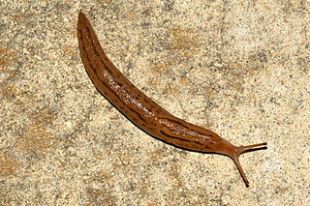
First in a series of posts on common gardening and farming pests. Next post in the series: Deer.
Slugs are a common gardening pest no matter what environment you live in, but I am going to share some information with you that may help you keep the pesky little buggers from homing in on succulent lettuce leaves, hostas, and generally causing havoc in your otherwise serene garden. Whether you live in Willamette Valley, the High Desert, or the Mid-Atlantic, they are everywhere. In fact, I’ve had two friends in the span of a week ask me about what they could do about them. So to help you guys and gals do battle against them, I’m re-posting this guide courtesy of gardensalive.com:
Thirteen Ways to Stop Slugs
1) Beer. Yes, it really does work. It’s also the best non-personal way to confirm that overnight damage is due to the slimy beasts. Just don’t use the often-cited “stale beer”, which slugs like about as much as you and I do. Place commercial traps or old margarine tubs on top of the soil close to the damaged plants, wait until dusk and then fill them with the cheapest—but freshest—beer you can find. The next morning, they should be filled with dead drunken slugs. Dump this defeated debris nearby (where it will attract their cannibalistic pals) and repeat every evening.
2) Coffee. New research has found caffeine to be very effective at dispatching slugs. Save your dregs and spray them full strength directly on the beasts in the evening. Surround plants under attack with a mulch of used coffee grounds to deter slugs and feed the plants.
3) Iron phosphate. Turns out that iron is very bad for a slug’s digestion. Like deadly bad. So a new generation of products with brand names like “Sluggo” and “
Escar-Go!” wrap iron in a slug-attracting bait. You simply scatter the pellets around plants in peril to wipe out the pests without poisons. (And a little extra iron is good for your garden soil.)
4) Copper. Slugs get shocked when they touch this shiny metal. You can buy ready-made copper plant guards or just adorn your raised bed frames with copper flashing. Hot-glue rings of pennies around the tops of your containers. Drop captured slugs into a jar of pennies and watch ‘em spark!
5) Diatomaceous earth. Available at garden centers, ‘DE’ is the mined fossilized remains of dinosaur-era, sea-going creatures called diatoms. It looks like white flour, but is incredibly sharp on a microscopic level, dehydrating slugs on contact. Surround plants under attack with protective rings of DE (be sure to wear a dust mask); freshen them up if they get wet.
6) Boards. Lay some old planks between your garden beds. The vampiric slugs will crawl underneath to hide from the sun. Come morning, lift the boards and scrape the slugs into a bucket with a flat piece of metal. Then do with them what you will. Hey—got any pennies?
7) Human hair. Surround your plants with a protective barrier of hair. The slugs will get all tangled up in it and strangle (hey—it was them or the hostas!); and the hair will eventually add plant-feeding nitrogen to the soil.
8) Citrus. Leave lemon, orange and grapefruit rinds out overnight near slug prone plants, and then collect and trash them—covered with slugs—first thing the next morning. Old lettuce leaves work well too.
9) Vinegar. A spray bottle filled with plain white vinegar is a great cure for slugs that aren’t on plants. An extremely effective mollusk dissolver, vinegar is also an herbicide—so don’t spritz the salvia.
10) Toads. Avoid all pesticides, provide water low to the ground and a damp shady spot for them to hide during the heat of the day, and these wonderful nocturnal predators will eat lots of slugs for you.
11) Rove beetles. These big black bugs don’t bother plants, but do eat LOTS of slugs and their eggs. So don’t hurt them!
12) Lightning bugs. The larval form of these summertime entertainers, the fascinating “glowworm,” eats slugs and their eggs. To encourage adults to breed nearby, turn off outdoor lights at night, allow a small area of your garden to stay moist and a little weedy, and don’t use pesticides.
13) Ducks! Just turn a few loose in the garden—these feathered friends (and natural fertilizer providers) are among nature’s FINEST slug-eaters! And all together now: “We can always use the eggs”. Thank you.
You Bet Your Garden Question of the Week ©2005 Mike McGrath




